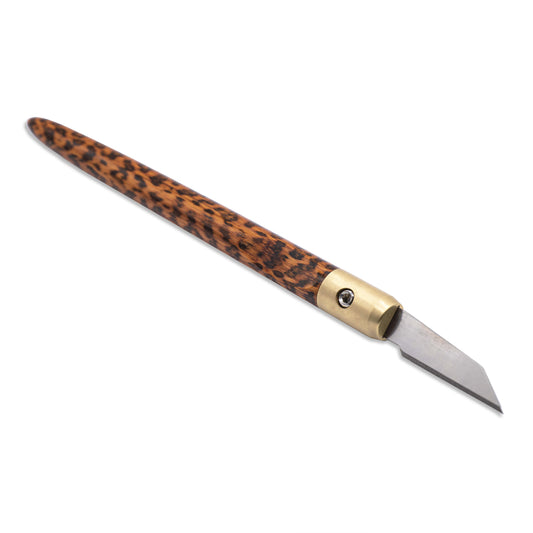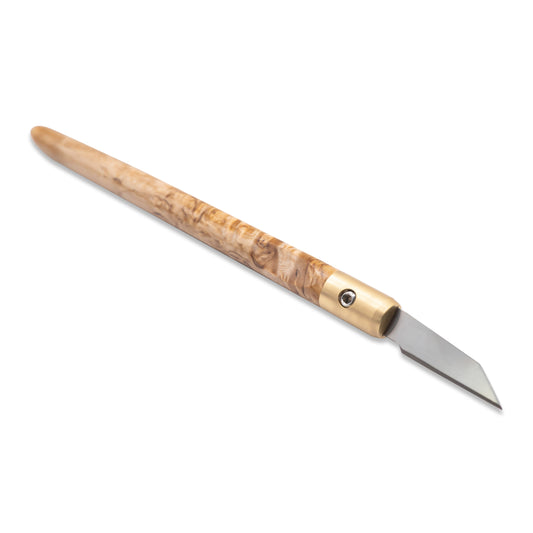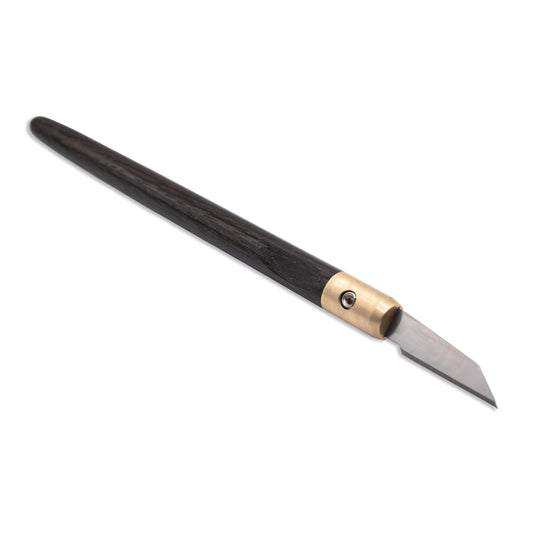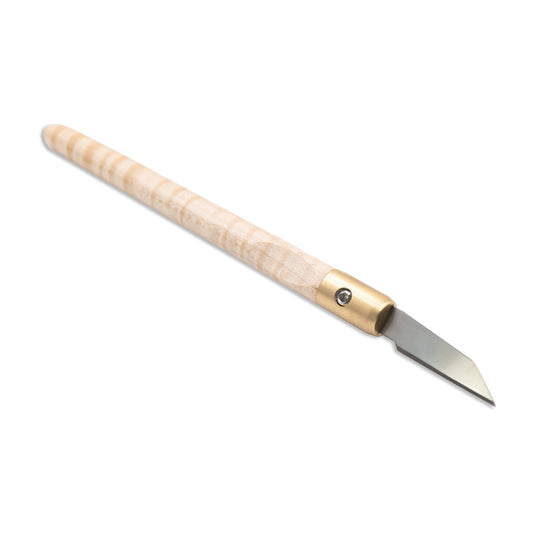KNIFE GRADING EXPLAINED
Snakewood
Snakewood is often sourced from South America and is probably one of the most stunning woods out there. However it comes at a price. Not only is it incredibly difficult to source, but much of the log is unusable due to large voids and splits that are commonly found throughout the material. As a result, yield is often very low from this already rare and expensive material.
-

Premium
Depending on the quality of the log I source my blanks from, only 0-5% will qualify for ‘Premium Grade. Handles of this grade must include heavy, tight and uniform figure over the entire handle with high contrast between the lights and darks. It must also be completely free of defects
-

A-Grade
A-Grade Snakewood handles must be figured over the entire handle, or have heavy figure akin to Premium Snakewood on one face (ideally the face with the thumb hold and grub screw.) This grade frequently includes handles that were almost Premium Grade but didn’t quite meet the mark.
-

B-Grade
B-Grade Snakewood handles include small amounts of figure, but not enough to match the criteria of A-Grade Snakewood. Again, this grade frequently includes handles that were almost A-Grade but were downgraded for the avoidance of doubt.
Masur Birch
Masur Birch is not a species of Birch, but is actually a pattern that is occasionally found within Birch. You can find out more about this incredible material here. Unfortunately for me, when this material is turned down to such thin sections, short grain and instability can begin to cause issues. To combat this, all of my Masur Birch handles are impregnated and stabilised with resin (sometimes coloured resin) which minimises movement and helps add structure to the handles. It also seems to increase the depth in the figure too!
-

Premium
Premium grade Masur Birch must include heavy figure on all faces made up of clusters of brown swirls and curliness from the wild grain patterning.
-

A-Grade
A-Grade Masur Birch must include heavy figuring on most of the faces, and will include both/either clusters of brown swirls and wild grain patterning.
-

B-Grade
B-Grade Masur Birch includes anything that didn’t match the criteria of A-Grade.
Curly Woods
Highly figured woods such as Curly Maple vary from board to board, or even across individual boards themselves. So as a result, I grade them based on their quality. If however I come across a wood that is not commonly figured, such as African Blackwood, this will be sold in the Specials section for it’s rarity.
-

Premium
Premium grade curly woods must include heavy and uniform figure on all faces of the knife with high depth and contrast in the rippling. I often source this stock from suppliers of luthier grade materials, which as far as figure goes is pretty hard to top!
-

A-Grade
A-Grade curly woods include heavy figuring on all faces, but lack either the depth, uniformity or contrast of premium grade handles. Handles of this grade may also include light discolouration from time to time, but nothing too serious.
-

B-Grade
B-Grade curly handles include small amounts of figure, but not enough to match the criteria of A-Grade. These handles often have light and/or uneven figure throughout, but are still figured enough to be classed as ‘curly’.
Specials
If a handle stands out as unusual or rare, I will class it as a ‘Special’ and place a small surcharge on the price. Below you’ll find some of the common characteristics found in these handles.
-

Coloured
I sometimes do limited releases of coloured tools to add a bit of vibrancy to my range. As of writing this post, all coloured tools are stabilised with coloured resin which both adds weight and durability to the tool.
-

Sappy
When I cut blanks from a solid board, some of them are cut directly along the sapwood creating this stunning contrast between the light and dark wood. If I deem it ‘cool’ enough, it will be classed as a special.
B-Stock (Otherwise known as 'Seconds')
(Not to be confused with B-Grade which relates to the quality / figuring of the wood)
Occasionally I screw up or a piece of wood is not all it seems to be. But instead of discarding it, I sell it as B-Stock to prevent wastage and to make the hit on peoples wallets slightly less severe. The majorty of these defects are very minor cosmetic flaws and are nothing to worry about. I just can’t bring myself to sell them full price. Below are common defects you may find in the B-Stock section.
Images below display Major defects. Therefore this is the absolute worst you can get...
-

Tearout
Tearout is a common issue with the highly figured woods I work with. I classify tools with tearout into 3 groups: Minor Tearout, Moderate Tearout and Major Tearout. This image shows major tearout in a Premium Curly Maple knife.
-

Ferrule Damage
Small dents or defects that may appear on the ferrule for varying reasons. (Often caused by my clumsiness when handling the knives.) This image shows a chip and a bad glue line between the Yew handle and Stainless Steel ferrule and is a major defect.
-

Splits
Some woods, often Snakewood, like to split while drying or in response to a heavy handed process. If a tool is sold with a split, it is purely a visual defect and has been stabilised before sale. This image shows a major split in a Purpleheart knife.
-

Bumps
A bump describes the transition between the handle and ferrule. I aim for this to be completely flush and seamless, but occasionally excessive handing on the handle can cause a small bump. This image shows a major bump in a Cocobolo and Steel knife.
Ready to Purchase?
-
Snakewood Marking Knife
Regular price From £110.00 GBPRegular priceUnit price / per -
Masur Birch Marking Knife
Regular price From £110.00 GBPRegular priceUnit price / per -
Bog Oak Marking Knife
Regular price From £110.00 GBPRegular priceUnit price / per -
Curly Maple Marking Knife
Regular price From £95.00 GBPRegular priceUnit price / per




















